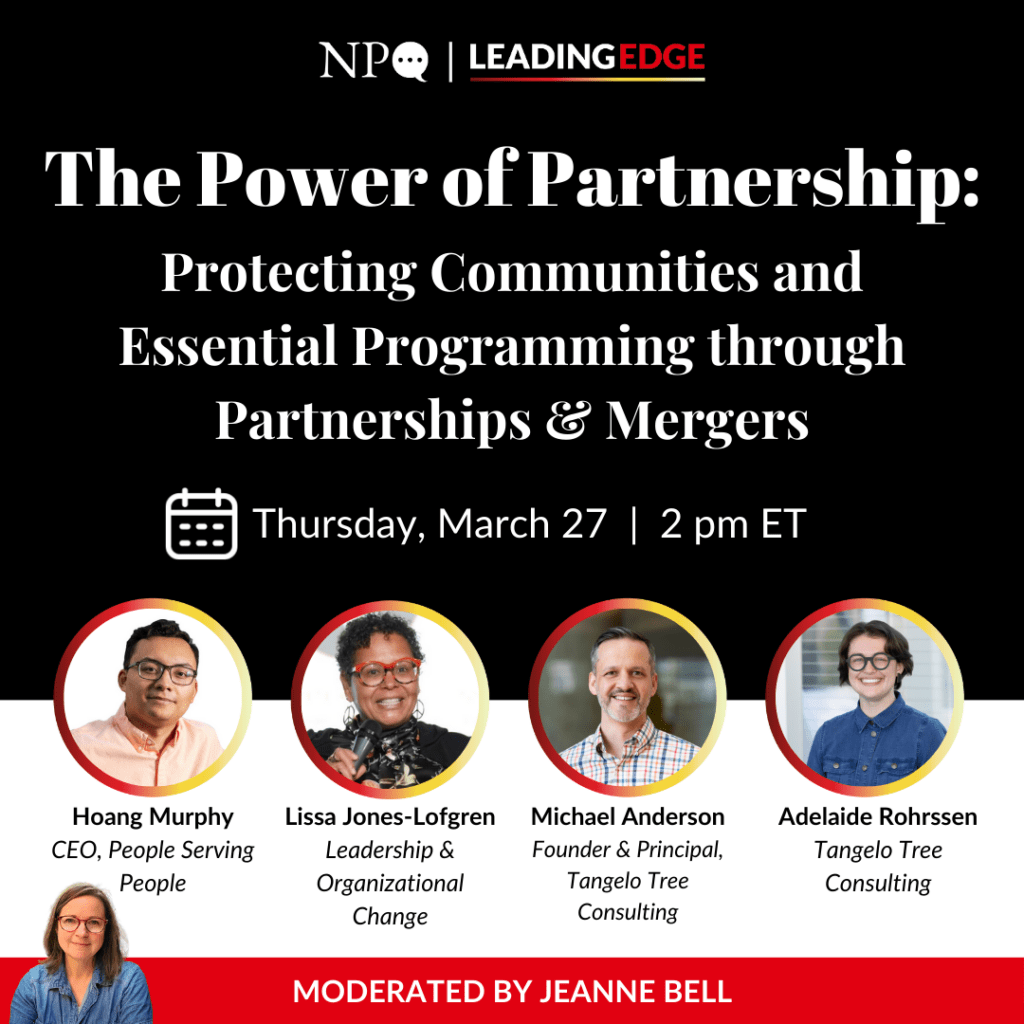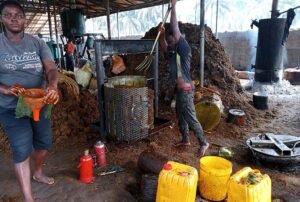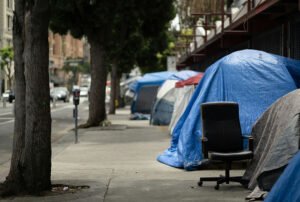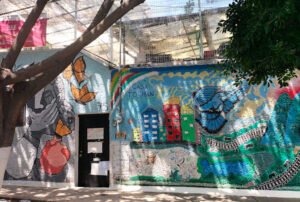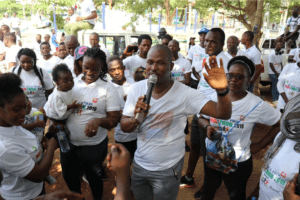
Click here to download this article as it appears in the magazine, with accompanying artwork.
Editors’ note: This article is from the Spring 2022 issue of the Nonprofit Quarterly, “Going Pro-Black: What Would a Pro-Black Sector Sound, Look, Taste, and Feel Like?”
Always bear in mind that the people are not fighting for ideas, for the things in anyone’s head. They are fighting to win material benefits, to live better and in peace, to see their lives go forward, to guarantee the future of their children. National liberation, the struggle against colonialism, the construction of peace, progress and independence are hollow words devoid of any significance unless they can be translated into a real improvement of living conditions.
—Amilcar Cabral1
Amilcar Cabral, Pan African leader of the Guinea-Bissau and Cape Verde national independence struggle, wrote and spoke extensively about the need to fight for tangible, material changes for our communities. For Cabral, the wave of global independence movements by Africans and other (Western-titled) “Third World” peoples was always about returning power from imperialist and colonial forces to everyday people. Today, this aim for social change workers remains the same, if not more pronounced. Our work is always to build power, not engage in ideological debates that only advance a few.
At CompassPoint (CP), we define power as the capacity (which includes will, resources, time, access, and more) to shape the outcomes of one’s circumstances. Our work has been on a six-year-long antiracist path that has led to power building rather than challenging anti-Blackness or building for diversity, equity, and inclusion.2 As an objective of our racial justice goals, we seek to grow power for our staff (and community) who are marginalized, with a focus on Black women. In February 2019, Building Movement Project released the report Race to Lead: Women of Color in the Nonprofit Sector, by senior research associate Ofronama Biu, which surveyed more than four thousand nonprofit staff (women of color made up 32 percent, about 1,280 respondents).3 It describes the all-too-familiar status quo:
Women of color described being passed over for opportunities for new jobs or promotions, often in favor of white and/or male candidates with fewer qualifications. They observed that men, particularly white men, tended to advance faster—even if they were underqualified—and were given more professional development opportunities. They wrote that directors did not see women of color as leaders and withheld projects and advancement opportunities.4
The report yielded three major findings: (1) racial and gender biases create barriers to advancement for women of color; (2) education and training are not enough to help women of color advance; and (3) the social landscape within nonprofit organizations can create conditions that undermine the leadership of women of color.5 All of these issues require a shift in power in order to transform.
These findings and assertions—and more—are no surprise for BIPOC leaders in the sector; after all, organizations are a reflection of the broader white settler colonial project that drove the genocide of Indigenous peoples and the enslavement of Africans. The colonial project is premised on stripping BIPOC people of the power in their lives. Thus, our social change work must be focused on dismantling the white settler colonial project and building power for all people oppressed by the project’s subsequent systems. As a result of building power for Black people, we build power for all oppressed peoples (inside and outside our organizations); that is, when we center Black people, we uplift all people. The Haas Institute for a Fair and Inclusive Society’s [now the Othering and Belonging Institute] Targeted Universalism primer describes this,, asserting that when those most marginalized build power to shift policy that benefits them, it has the capacity to benefit other marginalized peoples.6
We have experienced this truth at CompassPoint. Our former staff set off on a journey to redefine CP as an equity and social justice organization back in 2016.7 When we began to move past equity as a frame and introduced a more nuanced pro-Black power stance (surfaced by our former co-director Lupe Poblano), we began to see the potential of understand- ing and expanding power. For instance, in 2018, we examined dependent insurance coverage for our staff, predicated on the principle of supporting the Black mothers in our organization. In 2022, CP passed a 100 percent dependent coverage provision for all staff, regardless of number of dependents. When Black staff developed an affinity group to build unity and discuss experiences of anti-Blackness within the organization, affinity groups for all staff commenced. Affinity groups have created a critical reflective space for relationship building for participants, for white and BIPOC staff to understand and dismantle their participation in anti-Blackness, and for staff to be able to surface requests to the organization safely. It was our affinity group of coordinators who led the way to CP bringing all our workshops online during COVID and emerging with a how-to manual for virtual learning. These examples and many more have been at the crux of several structural, policy, and procedural changes at CP, including reimagining staff compensation and employee benefits,8 increased program monies for Black programming (including for our Self-Care for Black Women in Leadership program, which evolved from a program funded internally to one that has so far graduated five cohorts with the support of multiple funders),9 and hiring our first Black (woman) executive in CP’s nearly forty-seven-year history.10
The Failures of Diversity, Equity, and Inclusion (DEI)
Examples like CompassPoint’s and other organizations’ pro-Black efforts provide a way forward and data to help others with their power-building efforts. A good start for an organization wanting to take on pro-Black power building is to redirect one’s attention away from two current popular approaches and frames: organizational anti-Blackness and diversity, equity, and inclusion (DEI). Organizations advancing the theory and praxis of building pro-Black power include Tides Advocacy, whose mission statement reminds us that “Our Focus on Justice Requires Us to Be Pro-Black Every Day”;11 Equity in the Center, which is partnering with the BIPOC Project to deliver a training titled “Building Black Power: Dismantling Anti-Black- ness in Our Institutions and Movements”;12 and Essie Justice Group, which in 2020 took on an intersectionality lens to develop a webinar and tools titled “Black Feminist Institution Building: Employee Policies in the Age of COVID & Uprising in Defense of Black Life.”13
The presiding concentration on confronting anti-Blackness often requires that Black staff define, defend, and solve their own experiences of oppression within organizations. Using pro-Black power as a frame draws in white staff and staff of color to interrogate their own anti-Black bias, as well as drawing the organization into challenging the systems, processes, policies, and practices, not just interpersonal behaviors or attitudes. It also allows us to center our efforts on solutions that materially shift the conditions of Black people, instead of diagnosing whether anti-Blackness is “actually a problem” within our organizations (a dangerous phenomenon that we see all too often).
Analogously, DEI initiatives often miss the interdependence of organizational components. This is not to say that the many DEI staff and officers who we admire, work with, and champion aren’t doing work that is fundamental. It is to say that diversity, equity, and inclusion frameworks and initiatives miss the mark, because they consistently fail to clearly identify the fundamental need to shift power in an organization. In 2019, the Harvard Business Review published the article “Does Diversity Training Work the Way It’s Supposed To?,”detailing the results of their experiment to measure the effectiveness of diversity training.14 According to Harvard Business Review, the results (published in the Proceedings of the National Academy of Sciences) found “very little evidence that diversity training affected the behavior of men or white employees overall—the two groups who typically hold the most power in organizations and are often the primary targets of these interventions.”15 We would venture to say it is indeed working as it’s supposed to—to intentionally not shift power. DEI initiatives have ignored the centrality of power, rather heavily focusing on diversity training—among other interventions—as the antidote to challenge (interpersonal) anti-Blackness. Additionally, DEI staff are isolated with few resources to do more than address one issue at a time, usually focusing on interpersonal relationships between staff wherever anti-Blackness is embedded.
Sign up for our free newsletters
Subscribe to NPQ's newsletters to have our top stories delivered directly to your inbox.
By signing up, you agree to our privacy policy and terms of use, and to receive messages from NPQ and our partners.
We are inspired by several alternative approaches and frames to DEI. Namely, we draw from Dr. Angela Davis, who tells us, “If we do not know how to meaningfully talk about racism, our actions will move in misleading directions.”16 The work of building pro-Black power allows us to journey in the right direction to meaningfully dismantle the vestiges of white settler colonialism that produce power disparities in our organizations. We also draw from Aida Mariam Davis (Dr. Angela Davis’s niece-in-law), CEO and founder of Decolonize Design, whose article “Diversity, Equity and Inclusion have failed. How about Belonging, Dignity and Justice instead?” clarifies, “The DEI industrial complex came into existence as a pre- emptive defense to avoid litigation by members of protected classes, particularly under Title VII of the Civil Rights Act of 1964.”17
Finally, we rely heavily and unequivocally on bell hooks’s Feminist Theory: From Margin to Center, in which she asserts that in order to shift power, we must examine (1) how power has historically oppressed groups of people who are at the margins (in organizations, this is often BIPOC women and others who hold identities from traditionally oppressed communities), and (2) those who are at the center (in organizations this is often people who hold positions of authority, such as an executive director or a board member).18 hooks advises that to shift power, we must bring people from the margins into the center. This theory is integrated into all our workshop and training offerings, and has proven invaluable when starting conversations that examine power and privilege.
Interrogating Governance to Construct a Pro-Black Organization
Since 2016, CompassPoint has engaged in reexamining our entire organization to dismantle white supremacy. This has required an active and intentional redesign of every detail of CP.19 In 2020, we stepped more deeply into this liberatory work—that is, we moved beyond equity to build a pro-Black organization. And in 2021, we realized that in order to build a pro-Black organization, we needed a more comprehensive framework. To help us continue evolving our praxis as a pro- Black organization, we developed an organizational model premised on a governance framework. Developing this model has allowed us to live into our core strategy, which is to live liberation from the inside out.20 We build structures, cultural practices, business strategies, and approaches to organizational change that bring us and the people with whom we work closer to liberation. We try on practices from the inside so that we can practice and then share what we’re learning. At the same time, we study ways in which leaders outside our practice are living into liberation, so that we can bring new learning in, creating a cycle of mutual reflection, practice, and change. We use the definition of governance from the Indigenous Governance Toolkit, which defines governance as “how people choose to collectively organise themselves to manage their own affairs, share power and responsibilities, decide for themselves what kind of society they want for their future, and implement those decisions.”21 This framework includes several interrelated components: values, principles, structure, decision making, culture, and community engagement.
We are developing practices around values that our Black staff hold in high regard, such as communalism, self-care, authenticity, distribution of power, transparency, and healing. These practices are our principles, and our principles shape our structure—our systems, practices, policies, and procedures. Our organization is structured in three circles that allow for the sharing of power among staff, regardless of titles (a form we experimented with years ago, before endeavoring to build a pro-Black organization, when we explored the holacracy model).22
For example, our internal resilience circle, which coordinates all things traditionally understood as “operations” and “human resources,” manages our hiring processes for staff. Equipped with our commitment to distributing power, staff whose titles are “coordinator” or “associate director” in these circles often lead and participate in our hiring processes. Among other things, this builds confidence and a sense of ownership for all staff. This structure directly lends itself to the democratic decision-making processes we embark on at CompassPoint, because using modified consensus on major decisions allows staff—particularly Black staff, who often have little to no space in society to shape their circumstances—to shape the circumstances of the organization. All of this—the values, principles, structure, and decision making—shapes the culture of the organization, which at CompassPoint we articulate as the norms, traditions, practices, expectations, ways of being, histories of being (including Ancestral knowledge), beliefs, and desires of our staff. It also shapes how we engage with our communities. When we feel misaligned regarding any circle, we take the time to dissect why—often tracing back to our values—and construct a more aligned way forward. And we have found that when we’ve experienced a more aligned way forward, it’s been when Black staff are centered.
All of these components of governance, if done with the values that Black people hold at the center, can go a long way to shaping a pro-Black organization. What’s additionally critical is to constantly build a foundational staff understanding of this governance approach. In fall of 2021, we instituted organization-wide political education; using Cyndi Suarez’s book The Power Manual: How to Master Complex Power Dynamics, we engaged in a five-part internal study to dissect power in our lives and our organization.23 Fundamentally, we all now understand that ongoing political education builds power, because it builds the structural and conjunctive analysis of staff—an essential ingredient for understanding and shaping circumstances. Indeed, political education is fundamental to building a pro-Black organization—just as fundamental as our external workshops and cohort leadership programs that aim to build power within our community of participants.
Supporting Organizations to Build Pro-Black Structures
CompassPoint designs and delivers intensive cohort leadership development programs, which bring leaders together in learning communities. These programs combine a set of core methodologies, including teaching, peer learning, coaching, and physical practice. In 2021, we launched our inaugural B.L.A.C.K. Equity Intensive, to take the work we did to begin transforming CompassPoint into a pro-Black organization and share it with our community.24 Twenty-seven participants, organized into nine teams of three, met online for six sessions between February and October 2021. We started with the premise that to catalyze change in an organization, it’s important to have multiple people pushing from within. We aimed to build community, explore equitable structures, ground in a pro-Black political stance, and build agency, all while stepping into our power. We used principles of popular education to create learning experiences that uphold self-determination, democratize participation, and engage everyone as both a teacher and a learner—all fundamental components to building pro-Black power. Popular education, a pedagogical approach to teaching and learning developed by educator Dr. Paulo Freire, aims to transform society by centering the experiences of everyday people.25
A few key tenets embedded in this pilot program will continue to be central to our power-building practice and continued programs and our cohort leadership programs. The tenets are the following:
- Build intentional community among people who are working to dismantle white supremacy in their organizations. Meaningful racial justice work is deeply challenging, and can be sustained most effectively when we come together and support each other as whole people—hearts, minds, spirits, bodies—who are actively in the struggle to create pro-Black organizations.
- Ground in the power of small teams. This program is designed with an understanding that small teams of deeply connected and aligned people can effect changes in the larger systems around them. The program relies on the power of small teams with diverse perspectives (in both social positioning and organizational hierarchy) working together to more deeply understand the nuances of how their specific organization perpetuates racism, and design equitable cultures, structures, and practices in response.
- Amplify existing momentum. All racial justice work has to start somewhere, and the systems of inequalities in our sector are both broad and deep enough that a wide variety of organizational interventions and supports is likely needed to shift the full system. At CompassPoint, we are currently focusing our efforts with teams and organizations where there is already explicit racial justice work underway—linking with folks who are not at the beginning of this journey but rather already on their way.
- Learn across organizations. Racial justice work requires multiple layers of learning—within ourselves, among our teams, and within our organizations. Our approach supports these and offers an additional layer—learning from people doing this work in other organizational contexts—that can sometimes help catalyze areas where a team may be stuck, or help calibrate a team’s understanding of where they are on their racial justice journey, and how their particular struggles are both common and unique. This learning can be deepest and most impactful when it unfolds in an intentional community in which people have been invited to be whole, vulnerable, honest, and Sharing directly and deeply about our experiences cross-organizationally opens up a deeper level of learning than does just reading others’ stories or case studies.
- Challenge traditional dependence on expertise. We are active co-learners in our programs, advancing our own efforts to deepen racial equity at CompassPoint through our facilitation of and participation in this learning community. The CompassPoint facilitation team serves as another, tenth team in the cohort, as we are actively working on our own internal efforts to continue to grow racially just structures and practices while designing and facilitating this learning community. Given this, in addition to the processes named above, we draw from our direct experiences with this work to offer inspiration, support, and practical tools to guide small teams in seeding new possibilities for pro-Black structures and practices in their organizations.
***
Building pro-Black organizations is a necessity if we are to achieve our goals of liberatory transformation. It requires us to depart from solely challenging anti-Blackness or engaging in DEI efforts that don’t seek to shift power. Inspired by our theoreticians, fellow organizations in the field, and a community of participants, we are committed at CompassPoint to resourcing the time and efforts needed to build pro-Black power in our organization and with our partners and community of participants. We aim to grow and scale the impact of this work, increase its accessibility, and share learnings and tools with more organizations and with the sector more broadly. We invite our community, including the organizations we serve, partners in the field, and philanthropic partners, to join us on this journey.
Notes
- Return to the Source: Selected Speeches of Amilcar Cabral, African Information Service (New York: Monthly Review Press, 1973).
- While the title of this article uses the phrase “pro-Black organization,” it could just as well be “pro-Blackness” (“What It Looks Like to Build for Pro-Blackness”) or “pro-Black power” (“What It Looks Like to Build for Pro-Black Power”).
- Ofronama Biu, Race to Lead: Women of Color in the Nonprofit Sector (New York: Race to Lead, Building Movement Project, February 2019).
- Ibid, 9.
- Ibid.
- john powell, Stephen Menendian, and Wendy Ake, Targeted Universalism: Policy & Practice (Berkeley, CA: Haas Institute for a Fair and Inclusive Society, May 2019).
- “A Vision for Belonging,” CompassPoints of View (blog), CompassPoint, April 3, 2019, org/blog/ vision-belonging.
- “Reimagining Compensation Decisions through an Equity Panel,” CompassPoints of View (blog), CompassPoint, December 11, 2019, org/blog/reimagining-compensation-decisions-through-equity-panel.
- “Self-Care for Black Women in Leadership Program,” CompassPoint, accessed February 6, 2022, org/self-care-black-women-leadership-program.
- “Leadership Transitions: Liz Derias and Shannon Ellis Are CompassPoint’s Co-Directors,” CompassPoints of View (blog), CompassPoint, July 28, 2021, org/blog/leadership-transitions-liz-derias-and-shannon-ellis-are-compasspoints-co-directors.
- “Our Focus on Justice Requires Us to Be Pro-Black Every ,” Tides Advocacy, accessed February 6, 2022, tidesadvocacy.org/news/our-focus-on-justice-requires-us-to-be-pro-black-every-day/.
- “Building Black Power: Dismantling Anti-Blackness in Our Institutions and Movements,” Equity in the Center, accessed February 6, 2022, org/services/culture-trainings/building-black-power/.
- “Black Feminist Institution Building: Employee Policies in the Age of COVID & Uprising in Defense of Black Life,” Essie Justice Group, August 14, 2020, org/2020/08/black-feminist-institution-building-employee-policies-in- the-age-of-covid-uprising-in-defense-of-black-life/.
- Edward Chang et al., “Does Diversity Training Work the Way It’s Supposed To?,” Harvard Business Review, July 9, 2019, hbr.org/2019/07/does-diversity-training-work-the-way-its-supposed-to.
- See Edward Chang et al., “The mixed effects of online diversity training,” Proceedings of the National Academy of Sciences 116, no. 16 (April 16, 2019): 7778–83.
- Angela Davis, Freedom Is a Constant Struggle: Ferguson, Palestine, and the Foundations of a Movement (Chicago: Haymarket Books, 2016), 88.
- Aida Mariam Davis, “Diversity, Equity and Inclusion have How about Belonging, Dignity and Justice instead?,” World Economic Forum, February 23, 2021, weforum.org/agenda/2021/02/diversity-equity-inclusion-have-failed-belonging- dignity-justice/.
- bell hooks, Feminist Theory: From Margin to Center, 2nd (Boston: South End Press, 2000).
- To read more about our journey, see “Putting Racial Justice at the Heart: How Did CompassPoint Get Here?,” CompassPoints of View (blog), CompassPoint, March 6, 2019, org/blog/putting-racial-justice-heart-how-did-compasspoint-get-here.
- “Our Vision and Values,” CompassPoint, accessed February 6, 2022, org/vision-and-values.
- “1.0 Understanding Governance: 0.1 What Is Governance?,” Indigenous Governance Toolkit, accessed February 6, 2022, toolkit.aigi.com.au/toolkit/1-0-understanding-governance.
- For more on the holacracy model, see “Holacracy,” accessed February 7, 2022, org/explore.
- Cyndi Suarez, The Power Manual: How to Master Complex Power Dynamics (Gabriola Island, BC, Canada: New Society Publishers, 2018).
- “B.L.A.C.K. Equity Intensive: Building Love, Agency, Community, and Knowledge for Equity,” CompassPoint, accessed February 6, 2022, org/black-equity-intensive.
- For more on this, see “Paulo Freire,” Freire Institute, accessed February 15, 2022, freire.org/paulo-freire.


